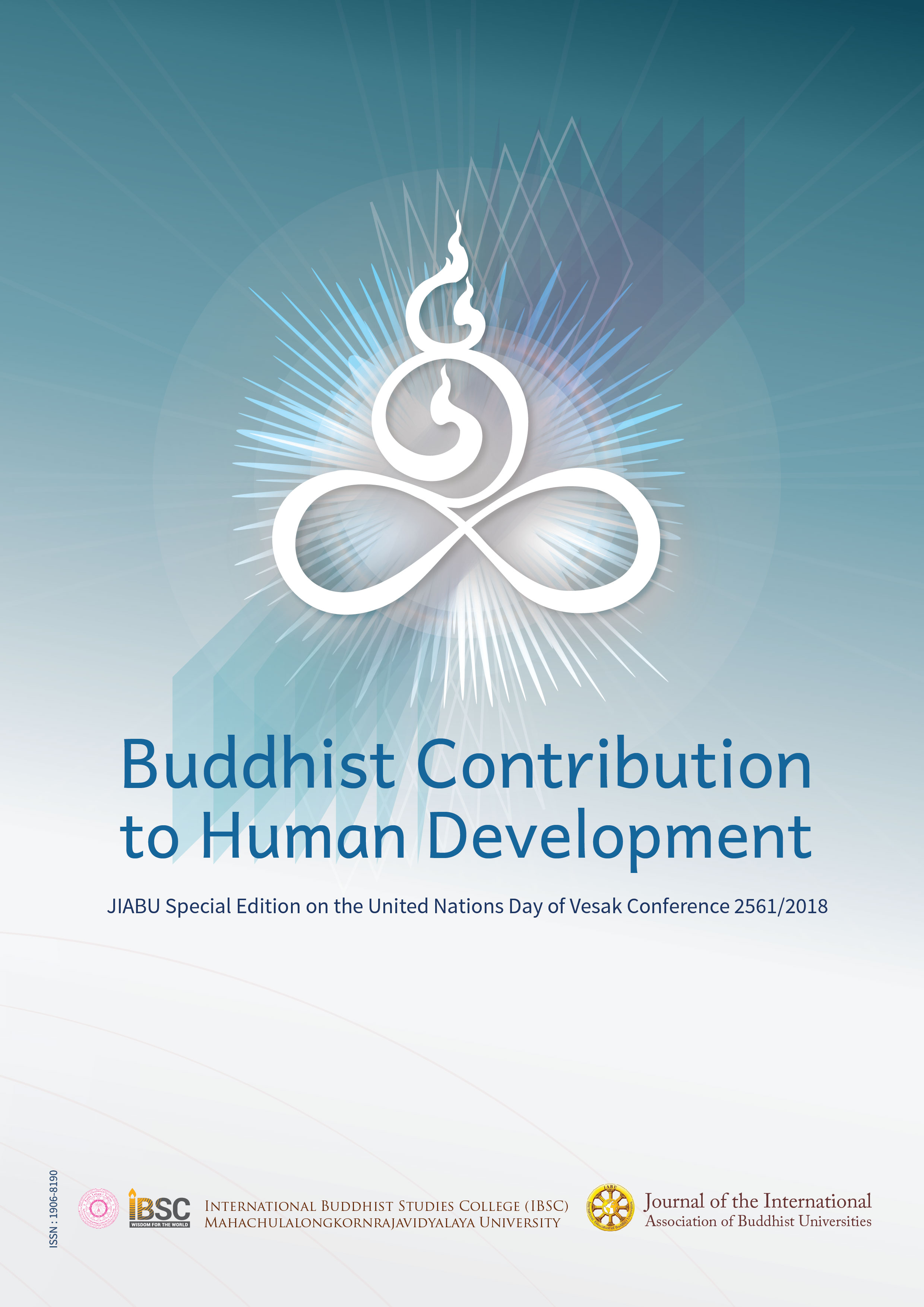A Study of Ānāpānasati based on the Visuddhimagga and the Vimuttimagga in the Perspective of Chinese Buddhism
Main Article Content
Abstract
Ānāpānasati, also known as mindfulness of breathing, is a method of breathing
meditation that has its roots in the Buddhist tradition and originates from the Buddha’s
time. The teaching of Ānāpānasati in two treatises of the Visuddhimagga and the
Vimuttimagga belongs to Theravada Buddhism. There are two objectives in this research,
which involve Ānāpānasati in the two treatises.
Ānāpānasati is the core teaching of meditation; based on these two treatises, the
author conducted a comparative study in the perspective of Chinese Buddhism. These
treatises with their detailed description of meditation practice have a special significance
in Buddhism.
This paper explores the eight or four stages of Ānāpānasati in two treatises and
emphasizes the meditation sign, the key to achieve the first jhāna. In systematizing the
practice of Ānāpānasati, both treatises create a structure based on the four foundations of
mindfulness.
Article Details
Views and opinions expressed in the articles published by The Journal of the International Association of Buddhist Universities (JIABU), are of responsibility by such authors but not the editors and do not necessarily reflect those of the editors.
References
Arahant Upatissa. The Path of Freedom, trs. from Chinese by Rev. N.R.M.
Bhadantācariya Buddhaghosa, The path of purification, tr. by Bhikkhu Ñāṇamoli, Buddhist Publication Society, 2010.
Ehara, Soma Thera and Kheminda Thera. Colombo: D.R.D. Weerasuria, 1961.
P.V. Bapat, Vimuttimagga and Visuddhimagga: A Comparative Study, printed by J.C. Sarkhel, Calcutta oriental press, Calcutta, 1937.
优波底沙著,黄夏年译,解脫道论(Huang-Xianian, Vimuttimagga),高雄:佛光文化事業有限公司,1998。
印顺,印度佛教思想史(Yinshun, History of Indian Buddhist Thought)台北:正闻出版社,1992。
吕澂,印度佛学源流略讲 (Lu Cheng, The Brief Lecture of the Indian Development ),上海:上海人民出版社,2005。
吴信如,禅定述要 (Wu-Xinru, The brief of meditation),北京:民族出版社,2002。
哈磊,四念处研究(Ha Lei, A Study of the Catvari Smarty-upasthanani), Dissertation of Ph.D. Si Chuang: Si Chuang University, 2004.
大正新修大藏经刊行会编,《大正新修大藏经》(Taishō Tripiṭaka)东京:大藏出版株式会社, Popular Edition in 1988.
巫白慧,《世界宗教研究》,“印度早期禅法初探——奥义书的禅理”1996年,第4期。
林崇安,《中華佛學學報》,“释尊时期止观法门的实践”,(Lin Chong’an, The meditation practice of Samatha and Vipassana in the age of Buddha)1997年,第 125-146页。
求那跋陀罗译,《大正藏》,《杂阿含经》(Taishō Tripiṭaka ,Saṃyukta Āgama),第2册,第99经,第5卷,第803经。
求那跋陀羅譯,《大正藏》,《杂阿含经》(Taishō Tripiṭaka ,Saṃyukta Āgama),第2册,第99经,第29卷,第808经。
王建光,魏晋南北朝时期的头陀僧,(Wang Jianguang, The dhūta monks in the Six Dynasties)《华林》第2 卷。中华书局, 2002 年。
瞿昙僧伽提婆译,《大正藏》,《增壹阿含经》(T., EĀ.),(增壹阿含经安般品第十七之一·一),第2册,第5卷,第125经。(和上面空格不同)
覃江,《西南民族大学学报,人文社科版》,“汉传‘安般念’传承考”,2005年第26卷,第 4期,第 282-284页。
覃江,入山捉猴:佛教安般念研究 (Qin Jiang, Catching the monkey in mountains: a study of Ānāpānasati in Buddhism),四川:巴蜀书社,2008.8。
觉音尊者著,叶均译,《清净道论》(Bhadantācariya Buddhaghosa, Visuddhimagga, tr. by Ye Jun),高雄:正觉学会,2000。
释大寂,《世界宗教学刊》,“《长部‧大念处经》中观呼吸法门与《瑜伽师地论》中阿那般那念之比较”,(Shi Daji, Compare the practice of breath in 'Mahasatipatthana Sutta' in Dīghanīkāya with the way of ānāpāna inYogācāra-bhūmi),2007年6月,第九期,第38页。
释大荷,《清净道论》“安那般那念”之古今诠释─以南传上座部佛使尊者与帕奥禅师为例 ,(Shidahe, On Ancient and Modern Explanatory Comments of ānāpānasati in Visuddhimagga – Taking Bhikkhu Buddhadasa and Pa-Auk Sayadaw as Examples), Master's Degree thesis. Yilan: Fo Guang University, 2008.
释自鼐,《成大中文学报》,“佛典中修习禅定过程的诠释——以《 清净道论》[观呼吸] 禅定过程为例 ”(Zinai Shi,The Interpretation of Meditative Process in Buddhist Texts: the Practice of Mindfulness of Breathing (ānāpānasati) in Visuddhimagga as an Example), 2007年,第87-124页。
黄夏年,《南亚研究》,“觉音的《清净道论》及其禅法”(Huang-Xianian,“Buddhaghosa's Visuddhimagga and His Practice of Dhyana”),1989年,第1期,第26-36页。


